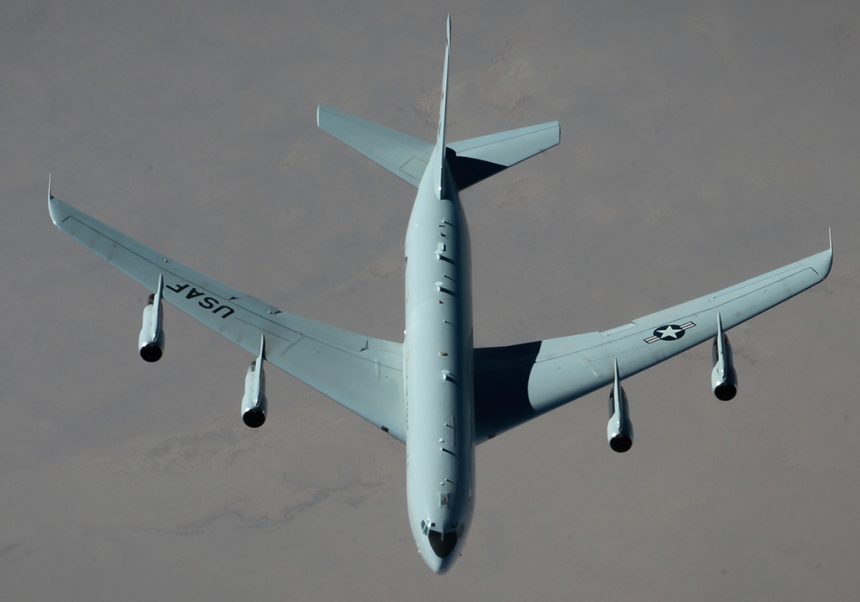According to a South Korean newspaper, Washington might sell the E-8 aircraft to Seoul. Meanwhile, a JSTARS frequently operates south of the DMZ.
The E-8C Joint Surveillance Target Attack Radar System is a joint U.S. Air Force – Army program.
The JSTARS is an airborne battle management, command and control, intelligence, surveillance and reconnaissance platform. It uses a multi-mode side looking radar to detect, track, and classify moving ground vehicles deep behind enemy lines. Its primary mission is to provide theater ground and air commanders with ground surveillance to support attack operations and targeting: through an antenna that can be tilted to either side of the aircraft to develop a 120-degree field of view, the JSTARS can cover nearly 19,305 square miles (50,000 square kilometers) and detect targets from a distance of 250 kilometers. Although the E-8C’s role is to build and update the picture of the battlefield, focusing on ground and moving targets, the the radar has also limited AEW-like capabilities: it can also detect helicopters, rotating antennas and low, slow-moving fixed wing aircraft even though these are partially hidden in the ground clutter. Surveillance data can be relayed in near-real time to the Army and Marine Corps common ground stations and to other ground command, control, communications, computers and intelligence, or C4I, nodes.
In other words, the E-8C, currently operated by the U.S. Air Force through the 116th ACW, is a key asset, that has not been exported outside the US. However, South Korea officially requested the JSTARS system during a Security Consultative Meeting with the United States late last month, The Dong-A Ilbo, a South Korean newspaper, reported on Nov. 3.
“South Korean defense officials, including Defense Minister Song Young-moo, cited the JSTARS as a top priority system with which to cope with North Korea’s nuclear and missile threats. […] Washington responded by expressing it will to positively consider the request. In a joint statement after the security meeting, the two allies agreed to strengthen cooperation in the South Korean military’s acquisition of state-of-the-art U.S. weapons systems.
The JSTARS, which played key roles in the Gulf War and Iraq War, was deployed to South Korea in November 2010 for the first time to closely monitor the North Korean military’s movement immediately after the North’s artillery attack on South Korea’s frontline island of Yeonpyeong Island. It was also deployed to South Korea during last month’s joint naval exercise on the South Korean waters, along with a U.S. nuclear powered aircraft carrier battle group.”
Actually, a U.S. E-8C has been operating over South Korea, not far from the DMZ, for a few weeks. In fact, even though the presence of the JSTARS not far from North Korea is not a surprise, since the aircraft is probably constantly updating the position and monitoring the movement of the North Korean forces along the border and across the peninsula, it’s at least worth of note that an aircraft has frequently showed up on flight tracking websites since Oct. 21, more or less when Seoul voiced its interest in the asset.
Once again, the aircraft could be tracked online because of its Mode-S transponder.
Heading north over South Korea
🇺🇸 US Air Force
E-8C Joint STARS
99-0006 RONIN31 pic.twitter.com/wGIWZViWY4
— CivMilAir ✈ (@CivMilAir) 21 October 2017
Oct. 31:
South Korea region – caught on @ADSBTweetBot
🇺🇸 US Air Force
E-8C Joint STARS
99-0006 RONIN32 https://t.co/INACVSztE3
— CivMilAir ✈ (@CivMilAir) 31 October 2017
Nov. 2:
Heading north over South Korea
🇺🇸 US Air Force
E-8C Joint STARS
99-0006 RONIN33 pic.twitter.com/XHHmQrOO4t
— CivMilAir ✈ (@CivMilAir) 2 November 2017
As said, the presence of an E-8 (99-0006) in the skies over South Korea is pretty normal. We don’t know whether the aircraft had South Korean observers on board or was involved in a sort-of demo but what’s really unusual is the fact that such a “strategic surveillance aircraft” could be tracked online. However, as we have already reported several times, many millitary aircraft, including spyplanes and drones remain visible on flight tracking websites regardless to whether they are involved in an operative mission or a ferry flight and years after we started highlighting the risk of breaking OPSEC with an inaccurate use of ADS-B transponders. So much so this author tends to believe those aircraft purposely broadcast their positions for everyone to see, to let everyone know it was there. A new way to wage Psychological Warfare and deter Pyongyang.
H/T Patrick Casey for the heads up and thank you again to our friend @CivMilAir for the outstanding coverage of milair traffic around the world.









